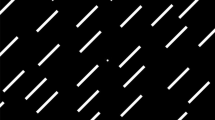Summary
Previous studies have described asymmetrical vertical eye movements when normal human subjects were rotated about a vertical inter-aural axis (with head rolled 90 degrees). We measured vertical eye movements induced by visual, vestibular and visual-vestibular stimuli with a magnetic scieral search coil technique while 10 normal subjects sat upright in a chair designed to rotate about the horizontal inter-aural axis at frequencies and amplitudes of natural head movements. Asymmetries in the gain of upward and downward pursuit and fixation-suppression of the VOR were found in individual subjects. However, there was no significant difference (p > 0.05) between the mean gain of up and down slow eye movements induced by vestibular, visual or visual-vestibular stimulation in the group of normal subjects. Systematic up-down asymmetries in vertical eye movements previously observed with testing about the vertical inter-aural axis were probably due to bias introduced by otolith stimulation and/or electro-oculographic eyelid artifact.
Similar content being viewed by others
References
Baloh RW, Langhofer L, Honrubia V, Yee RD (1980) On-line analysis of eye movements using a digital computer. Aviat Space Environ Med 51: 563–567
Baloh RW, Richman L, Yee RD, Honrubia V (1983) The dynamics of vertical eye movements in normal human subjects. Aviat Space Environ Med 54: 32–38
Baloh RW, Honrubia V, Yee RD, Hess K (1983) Changes in the human vestibulo-ocular reflex after loss of peripheral sensitivity. Ann Neurol 16: 222–228
Barnes GR, Edge A (1983) Non-linear effects in visual suppression of vestibular nystagmus. Exp Brain Res 52: 9–19
Barry W, Melvill Jones G (1965) Influence of eyelid movement upon electro-oculographic recording of vertical eye movements. Aerospace Med 36: 855–858
Benson AJ, Guedry FE (1971) Comparison of tracking-task performance and nystagmus during sinusoidal oscillation in yaw and pitch. Aerospace Med 42: 593–601
Collewijn H, van der Mark F, Jansen TC (1975) Precise recording of human eye movements. Vision Res 15: 447–450
Collins WE, Guedry FE (1967) Duration of angular acceleration and ocular nystagmus from cat and man. I. Responses from the lateral and vertical canals to two stimulus durations. Acta Otolaryngol 64: 373–387
Collins WE, Schroeder DJ, Rice N, Mertens RA, Kranz G (1970) Some characteristics of optokinetic eye-movement patterns: a comparative study. Aerospace Med 41: 1251–1262
Correia MJ, Perachio AA, Eden AR (1985) The monkey vertical vestibulo-ocular response (VVOR): a frequency domain study. J Neurophysiol 54: 532–548
Darlot C, Lopez-Borneo J, Tracey D (1981) Asymmetry of vertical vestibular nystagmus in the cat. Exp Brain Res 41: 420–426
Hixon WC, Niven JI (1969) Directional difference in visual acuity during vertical nystagmus. NAMI-1079, Naval Aerospace Medical Institute, Pensacola FL
Hyden D, Larsby B, Schwarz WF et.al. (1983) Quantification of slow compensatory eye movements in patients with bilateral vestibular loss. Acta Otolaryngol 96: 199–206
Lisberger SG, Evinger C, Johanson GW, Fuchs AF (1981) Relationship between eye acceleration and retinal image velocity during foveal smooth pursuit in man and monkey. J Neurophysiol 46: 229–249
Matsuo V, Cohen B (1984) Vertical optokinetic nystagmus and vestibular nystagmus in the monkey: up-down asymmetry and effects of gravity. Exp Brain Res 53: 197–216
Money KE, Friedberg J (1964) The role of the semicircular canals in causation of motion sickness in the dog. Can J Physiol Pharmacol 42: 793–801
Robinson DA (1982) A model of cancellation of the vestibuloocular reflex. In: Lennerstrand G, Zee DA, Keller EL (eds) Functional basis of ocular motility disorders. Pergamon Press, New York, pp 5–13
Yee RD, Schiller VL, Lim V, Baloh FG, Baloh RW, Honrubia V (1985) Velocities of vertical saccades with different eye movement recording methods. Invest Ophthalmol Vis Sci 26: 938–944
Author information
Authors and Affiliations
Additional information
Dr. Baloh is supported by NIH grants NS 09823 and EY 04556; Dr. Honrubia is supported by NIH grant NS 09823; Dr. Yee is supported by NIH grants EY 03737 and EY 04556, and the Dolly Green Research Scholar Award from Research to Prevent Blindness, Inc., New York
Rights and permissions
About this article
Cite this article
Baloh, R.W., Honrubia, V., Yee, R.D. et al. Vertical visual-vestibular interaction in normal human subjects. Exp Brain Res 64, 400–406 (1986). https://doi.org/10.1007/BF00340476
Received:
Accepted:
Issue Date:
DOI: https://doi.org/10.1007/BF00340476




